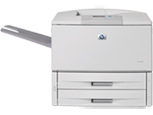
HP LaserJet 9050 Printer Review
The HP LaserJet 9000 was a flagship printer for use in high volume applications. It featured a high print speed, which was very popular. The 9000 was, however, had several issues that should be expected of any printer without a proper predecessor. The LaserJet 9040 and 9050 are HP’s followups to the LaserJet 9000, the latter of which will be discussed in more detail below.
The 9050 fixed a number of issues that the 9000 had, and it is what we think of when someone asks “What is a trouble free printer?”. It performs similarly fast with a print speed of 55 ppm. The 9000 had issues with its DC controllers, and the fuser would develop flat spots from sitting too long in the same position. The 9050 fixed both of these issues, the latter by simply rolling the fuser periodically. Small, common-sense changes like that mark the 9050, things you wouldn’t notice unless you look.
The 9000 series of printers all have a paper jam detection mechanism on the fuser. The paper jam detector worked by detecting the presence of paper wrapped around the fuser using a solenoid. The DC controller applies a voltage across the solenoid and the fuser, and detects the electrical resistance between the two. If a sheet of paper is there, the resistance is higher, and you have a paper jam. The old DC controller would often indicate false errors, but the new one performs much better. In the 9000 service manual, some of the fan errors and fan part numbers listed are incorrect. This too was also corrected in the 9050 service manual (and the 9040’s as well, in case you were wondering).
One problem we had hoped to see improved in the update was the fuser lamps failing. The fuser in the 9000 series has two lamps; if both lamps aren’t heating, you will get a 50.2 error as you could expect from any other printer. The catch is that if only one lamp is heating, you don’t receive an error, the printer just takes a long time to warm up (10-20 minutes, as opposed to 1-2 minutes). This can be caused by a bad fuser (one lamp burned out), or a bad power supply (the LVPS only powering one lamp). This didn’t change in the 9050, but we have seen the problem much more frequently on the 9000.
All of the printers in the 9000 series use the C8543X toner cartridge. The toner retails at $302.93 and has a yield of 30,000 pages at 5% coverage, which comes out to 0.0101 cents per page.* When using the aftermarket cartridge, available at $129.00, that cost comes down to 0.0043 cents per page.*
*These estimates use the industry-standard 5% coverage model, and only provide toner costs. The aftermarket cartridge cost was calculated using our customer pricing, available by phone, or in our online catalog.
Conclusion
The 9050 is what you should expect from a follow up printer. It fixes a lot of the problems it predecessor has, and performs comparably well. We found this printer to be easy to use, as well as very reliable. You may expect to get a few paper jams, but probably not if you change the pickup rollers fairly often. So, all in all, if you have a LaserJet 9000 and are leery about getting the newer LaserJet 9050 – don’t be. You may end up with a lot less headaches.
Helpful Information
Standard Cartridge C8543X
HP’s Page here
Drivers here
Product Sheet here

No comments yet.